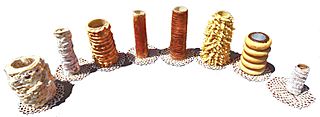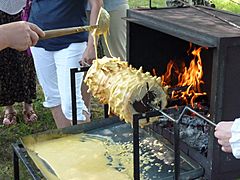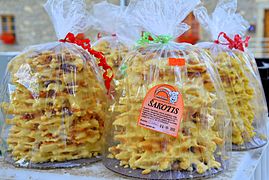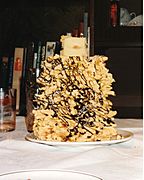Šakotis facts for kids
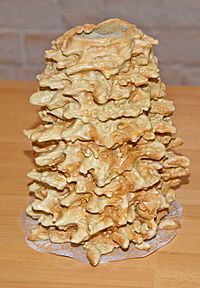
Lithuanian šakotis
|
|
| Alternative names | Sękacz (Poland) Bankucha (Belarus) |
|---|---|
| Type | Cake |
| Region or state | Lithuania, Poland, Belarus |
| Created by | German Baumkuchen |
Šakotis (pronounced shah-KOH-tis) is a special cake from Lithuania. It's also known as sękacz (SEN-kach) in Poland and bankucha (ban-KOO-kha) in Belarus. This cake is unique because it's cooked on a spinning stick, called a spit. It spins over a fire or in a special oven.
Šakotis is made with butter, eggs, flour, sugar, and cream. It's a popular dessert for celebrations in these countries.
Contents
History of Šakotis
This interesting cake became popular a long time ago. It was during the time of the Polish-Lithuanian Commonwealth (1569–1791). This was a very large country that included parts of modern-day Poland, Lithuania, and Belarus.
People aren't completely sure who first made this cake. Some say it was Bona Sforza, a Polish Queen. She was known for bringing new ideas to farming and building. Others think it came from the Yotvingians. They were an old Baltic tribe known for being great warriors and hunters.
Why it's called "Tree Cake"
The name šakotis means "branched tree" or "tree with many branches." You can see why when you look at it! It often has a pointy shape, like a pine tree. The drips of batter that form as it cooks look like branches.
Making this cake takes a lot of time and effort. Layers of batter are carefully painted onto a spinning spit. This happens in a special open oven or over an open fire.
When to enjoy Šakotis
You can decorate Šakotis with chocolate or flower designs. But it's also often served plain. In Lithuania, Šakotis is one of the most important desserts. People eat it at big celebrations like weddings. It's also popular during holidays such as Christmas.
In 2006, Šakotis was chosen to represent Lithuania. This was part of the Café Europe event for Europe Day.
Record-breaking cakes
In May 2015, a huge Šakotis was made in Druskininkai, Lithuania. It broke the record for the biggest one ever! This giant cake was about 372 centimeters (12 feet) tall. It weighed about 85.8 kilograms (189 pounds).
In Poland, a similar cake called sękacz from Masuria was added to a list of traditional products in 2006. In Belarus, a recipe for bankucha from Porazava was added to their list of historical and cultural heritage in 2019. In some parts of Belarus, bankucha is a wedding cake made with many egg yolks, sometimes as many as 60!
Other Spit Cakes Around Europe
Šakotis is part of a family of cakes called "spit cakes." These cakes are all cooked on a spinning stick. Many countries in Europe have their own version:
- Austria has Prügelkrapfen.
- Belarus has bankucha. Its name comes from the German word for "tree cake."
- The Czech Republic has Trdelník.
- France has Gâteau à la broche.
- Luxembourg has Baamkuch. This cake is often served at special events like weddings.
- Poland has Sękacz.
- Lithuania has Šakotis or Raguolis. In Western Lithuania, it's sometimes called Bankuchenas.
- Sweden has Spettekaka. This cake has a special protection from the EU. This means only cakes made in a certain way and place can use this name.
- Hungary has Kürtőskalács.
- Slovakia has Skalický trdelník. This cake also has special protection from the EU.
- Turkey has Makara tatlısı.
- Indonesia has Spekkoek. This cake was created when the Dutch ruled Indonesia. It's a firm, layered cake that is an Indonesian version of the European spit cake.
Gallery
See also
 In Spanish: Šakotis para niños
In Spanish: Šakotis para niños


